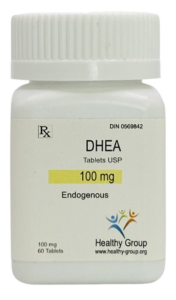Dehydroepiandrosterone Tablet, USP
DIN 0569842
100 mg
60 tablets, Square container

DESCRIPTION DHEA (Dehydroepiandrosterone), also known as androstenolone or prasterone (INN), as well as 3β-hydroxyandrost-5-en-17-one or as 5-androsten-3β-ol-17-one, is an important endogenous steroid hormone. It is the most abundant circulating steroid hormone in humans, in whom it is produced in the adrenal glands, the gonads, and the brain, where it functions predominantly as a metabolic intermediate in the biosynthesis of the androgen and estrogen sex steroids. However, DHEA also has a variety of potential biological effects in its own right, binding to an array of nuclear and cell surface receptors, and acting as a neurosteroid.
COMPOSITION Each tablet contains: Medicinal ingredients. Dehydroepiandrosterone, 100 mg. Non-medicinal ingredients. Microcrystalline cellulose, calcium carbonate, steric acid, magnesium stearate.
CLINICAL PHARMACOLOGY In women, the synthesis of DHEA and DHEAS occurs almost exclusively in the adrenal cortex, whereas in men, the testes secrete approximately 5% of DHEAS and 10-25% of DHEA. Minute amounts are synthesized de novo in the brain. In young adults, the adrenal cortex secretes approximately 4 mg of DHEA and 25 mg of DHEAS per day. During gestation, large amounts of DHEA and DHEAS are secreted by the fetal adrenal glands. At birth, output drops to negligible amounts in both sexes and remains that way until five to seven years of age. At the onset of adrenarche, the adrenal glands gradually resume DHEA and DHEAS production, which accelerates through puberty. DHEA and DHEAS output is maximal between the ages of 20 and 30, and then starts a decline of approximately 2% per year, leaving a residual of 10-20% of the peak production by the eighth or ninth decade of life. DHEA and DHEAS are interconvertible by sulfohydrolases in peripheral and adrenal tissues. Some 64-74% of the DHEAS produced each day is converted to DHEA, but only 13% of the DHEA produced is metabolized to DHEAS. In humans, the brain-to-plasma ratios for DHEA and DHEAS are 4-6.5 and 8.5, respectively, indicating a neuroendocrine role for these hormones. DHEA and DHEAS serve as the precursors of approximately 50% of androgens in men, 75% of active estrogens in premenopausal women, and 100% of active estrogens after menopause. There appears to be a sex-specific response to DHEA replacement therapy in humans. In postmenopausal women (ages 50-65), supraphysiological doses of 100 mg of DHEA per day have predominantly androgenic effects, increasing testosterone levels approximately 300% over baseline levels. In older men (mean ± S.D. age, 58.8 ± 5.1 years), 100 mg/day did not affect testosterone or dihydrotestosterone levels, but 17 beta-estradiol and estrone levels were increased over baseline by 37% and 225%, respectively (p < 0.0001 for both). It has been hypothesized that the increase in serum estrogens may provide a mechanism for beneficial cardiovascular effects in men.
INDICATIONS DHEA is prescribed at pharmacological dose (high dosage) for the treatment of systemi lupus erythematosus (rare autoimmune disease), rheumatoid arthritis and depressive syndrome. A physiological dose (it restores the rate that should normally be), is indicated in cases of adrenal insufficiency and andropause. However, according to the research from an endocrinologist in Munich, DHEA has a positive effect on osteoporosis and cardio-protective properties; it increases muscle mass, which explains the particular effects documented in cases of multiple sclerosis, and decreases the mass fat hence its interest also in obesity. DHEA protects the dermis, including a decreased number of skin spots due to sun exposure, an improvement of the condition and the thickness of the skin. This is an anti-depressant, an anti-stress and an immune stimulant. On the cardiovascular system, DHEA increases sensitivity to insulin, which naturally decreases with age, increasing the risk for diabetes, hypertension, and metabolic syndrome. Increasing fibrinolysis (the dissolution of clots), DHEA also decreases the risk of thrombosis and hence, stroke. To date, there are no data on the risk of breast cancer.
CONTRAINDICATIONS DHEA is a prohormone. High doses may cause aggressiveness, irritability, trouble sleeping, and the growth of body or facial hair on women. It may also stop menstruation and lower the levels of HDL (“good” cholesterol), which could raise the risk of heart disease. Other reported side effects include acne, heart rhythm problems, liver problems, hair loss (from the scalp), and oily skin. It may also alter the body’s regulation of blood sugar. DHEA should not be used with tamoxifen, as it may promote tamoxifen resistance. Patients on hormone replacement therapy may have more estrogen-related side effects when taking DHEA. This supplement may also interfere with other medicines, and potential interactions between drugs, herbs and this medication should be considered.
DOSAGE AND ADMINISTRATION A typical therapeutic dosage of DHEA is 50 mg to 200 mg daily, although some studies used dosages above and below this range. Physicians sometimes check DHEA levels and adjust the daily dose to achieve blood levels of 20-30 nmol/L.
STORAGE INSTRUCTIONS Store DHEA at room temperature, between 15-30 degrees Celsius (59° to 86° F), in a tightly closed, light-resistant container. Keep out of reach of children.
